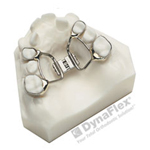 Paltal Expander
Paltal Expander
The palatal expander "expands" (or widens) your upper jaw by putting gentle pressure on your upper molars each time an adjustment is made. The animation below is a demonstration of how to turn the expander. Your orthodontist will have given you instructions on how many turns, and how often to make the turns to the expander. When you achieve the desired expansion, you will wear the appliance for several months to solidify the expansion and to prevent regression.
As a side note, there are also expanders that are used to widen the lower jaw. They are often made of colored plastic, are removable, and have an expansion screw in the middle of the appliance. They are taken out of the mouth to turn and usually have an indicator arrow showing you the direction to turn.
Adjusting the palatal expander
You can also download these instructions in a printable PDF document.
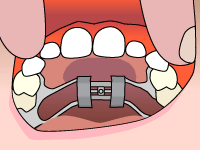
Step 1
In a well-lit area, tip the patient's head back.
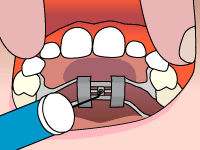
Step 2
Place the key in the hole until it is firmly in place.
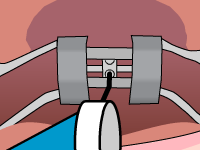
Step 3
Push the key toward the back of the mouth. You will notice the fender will rotate and the new hole will appear. The rotation stops when the key meets the back of the expander.
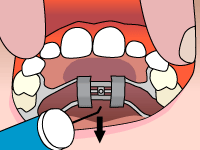
Step 4
Press back and down toward the tongue to remove the key. The next hole for insertion of the key should now be visible.
Herbst Appliance
Aside from the obvious benefits of orthodontic treatment, like increased confidence and ease of hygiene, another benefit is not so obvious: improved jaw function. If your child has a large overbite, simple treatment with braces may not correct the problem. The Herbst appliance, usually in conjunction with braces, is used to help the lower jaw develop in a forward direction. This eventually leads to an ideal bite. Left untreated, an improper bite may threaten the long-term health of your child's teeth, gums, and jaw.
A Herbst appliance is fixed to your child's molars. It includes a metal tube that connects the upper and lower jaw. By adjusting the tube, your orthodontist is able to control the jaw's position in relation to the upper teeth. Typical treatment time with a Herbst appliance is 12 months, though this may vary depending on your child's unique needs.
Herbst vs. Headgear
Compliance
The main difference between a Herbst appliance and headgear is that the Herbst appliance is securely fastened to your child's teeth, while headgear is removable. To be truly effective, headgear must be worn between 12 and 16 hours per day, which often poses a problem with patients who don't like to keep it on that long. Since the Herbst appliance is not removable, you won't need to keep track of how many hours per day your child wears it.
Aesthetic
Another difference is aesthetics. Headgear is bulky, made of metal hooks or a facebow, and straps or a head cap to anchor the headgear to the back of the head or neck. A Herbst appliance is a much more discreet option: it may be visible when your child laughs or speaks, but it is far less obtrusive than headgear.
Adjusting to a Herbst Appliance
Muscle Tenderness – When your child first gets his or her Herbst appliance, there may be some overall muscle tenderness and soreness of the teeth. As your child's mouth adapts to the appliance, the soreness should fade.
Tissue Irritation – Because the Herbst appliance is metal, it may cause some slight tissue irritation, especially on the lower gums. It will take time for your child's mouth to adapt. Until it does, dental wax can help to ease the irritation.
Diet – Eating softer food will help with any muscle soreness, especially after the first week or two after getting the appliance. It is also important to eliminate sticky foods, like candy and gum, or hard, crunchy food, which can damage the appliance and lengthen treatment time.
TADs
Temporary Anchorage Device (TAD)
Temporary anchorage devices, or TADs, are small titanium anchors used in certain orthodontic cases to help achieve quicker tooth movement with more efficiency and comfort. TADs may be used in addition to braces or as an alternative to headgear.
How are TADs placed?
A strong anesthetic is used to numb the gum tissue and the jaw surrounding the area where the TAD will be placed. Once the area is numb, your doctor will gently place the TAD through the gum tissue and firmly into the jawbone. The placing of a TAD is quick, and may be over before you know it. While your doctor is placing the TAD, you may feel slight pressure, but within a day, you will no longer be able to feel the TAD. Your TAD is removed once your treatment is complete, or when it is no longer needed to help straighten your teeth. Removal of a TAD is a comfortable procedure that takes just a few minutes.
What can I do to relieve discomfort caused by my TAD?
If you do feel any discomfort from having your TADs placed, Tylenol® is recommended to help relieve your pain. If you continue to experience discomfort days after your treatment, please contact your dentist as soon as possible.
How can I keep my TAD clean?
A TAD can be cleaned the same way you clean your braces: by brushing your teeth at least three times a day. When your TAD is placed, we will also provide you with an antimicrobial mouthwash that you will need to use twice a day.
If you have questions about TADs, please contact our practice. We will be able to answer any of your questions and provide you with detailed information about your orthodontic treatment.
